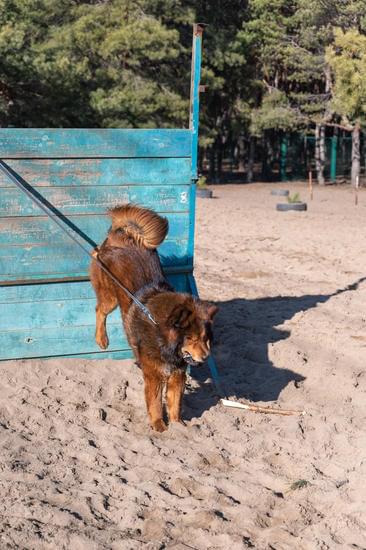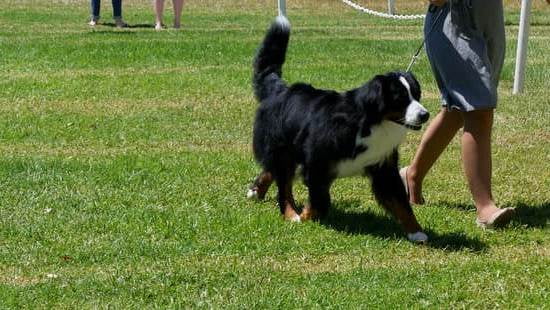Leash training is an essential skill for dogs of all ages, including older dogs. Taking the time to train your older dog to use a leash not only ensures their safety and control during walks, but it also provides them with mental and physical stimulation. In this article, we will explore effective methods for leash training older dogs and address any fear or anxiety they may have towards leashes.
Leash training is particularly important for older dogs as they may have different needs and behaviors compared to younger pups. Older dogs may have developed habits or fears that need to be addressed before they can confidently walk on a leash. By understanding the importance of leash training for older dogs, you will be equipped with the knowledge necessary to help your furry friend become comfortable and confident on a leash.
Before diving into the specific techniques, it’s crucial to assess your dog’s comfort level with leashes. Some older dogs may already feel anxious or fearful around leashes due to past negative experiences or lack of exposure. Recognizing any signs of fear or anxiety is crucial in creating a positive association with leashes during the training process.
By following the tips and techniques outlined in this article, you will learn how to gradually introduce your older dog to the leash while incorporating positive reinforcement techniques like treats and praise. We will also discuss choosing the right leash and troubleshooting common challenges that may arise during the training process.
Remember, consistency and patience are key when it comes to successfully training an older dog to use a leash. So let’s get started on this rewarding journey of bond-building through leash training.
Assessing the Dog’s Comfort Level
Understanding the Importance of Assessing a Dog’s Comfort Level
Before embarking on leash training for an older dog, it is crucial to assess their comfort level and any fear or anxiety they may have associated with leashes. Understanding the dog’s emotional state towards leashes will not only help in designing an effective training plan but also ensure the well-being and mental health of the dog during the training process.
Dogs can develop fear and anxiety towards leashes due to past negative experiences, lack of exposure, or even associating them with unpleasant activities like vet visits.
Recognizing Potential Signs of Fear or Anxiety
To effectively assess a dog’s comfort level with leashes, it is essential to recognize potential signs of fear or anxiety. These signs may include trembling, cowering, excessive panting, pacing, attempting to escape the leash, hiding, or displaying aggressive behavior such as growling or barking.
It is important to note that each dog may exhibit different signs based on their unique temperament. Observing and understanding these signs will enable trainers to tailor their approach and create a positive training environment for their older dog.
Creating a Safe and Positive Environment
To address any fear or anxiety associated with leashes, it is crucial to create a safe and positive environment for the older dog. This can be achieved by introducing them to the leash in a calm setting where they feel comfortable. Start by allowing the dog to investigate and sniff the leash at their own pace without any pressure.
Avoid using forceful methods as it can further reinforce negative associations. Reward any relaxed behavior around the leash with treats and verbal praise to establish a positive connection.
Once the initial introduction is successful, gradually progress by attaching the leash briefly while continuing rewarding good behavior. It is important to go at the dog’s pace and understand that some dogs may require more time and patience than others. The key is to create a relaxed and positive association with the leash, gradually building their confidence and comfort level. Remember, every successful interaction with the leash should be celebrated with rewards and encouragement.
By assessing a dog’s comfort level and recognizing any fear or anxiety associated with leashes, trainers can approach leash training for older dogs in a thoughtful and compassionate manner. This foundation of understanding will set the stage for creating a positive training experience that enables both physical exercise and strengthens the bond between the dog and their owner.
Gradual Introduction
One of the first steps in leash training an older dog is to gradually introduce them to the leash and familiarize them with its components. This approach helps the dog feel more comfortable and less anxious about wearing a leash. Here are some tips on how to start small and make the introduction process as smooth as possible:
- Begin by letting the dog sniff and investigate the leash: Before attaching the leash to the dog’s collar or harness, allow them to become familiar with it. Let them sniff and inspect the leash at their own pace. This helps them associate positive experiences with the leash.
- Attach and detach the leash multiple times: Once your dog is comfortable with the presence of the leash, gradually attach it to their collar or harness for short periods of time. Start with just a few seconds and gradually increase the duration over several days. Practice attaching and detaching the leash multiple times during each session.
- Practice indoors before moving outside: Initially, practice using the leash indoors where your dog feels safe and comfortable. This allows them to get used to wearing it without any distractions or overwhelming stimuli from outside.
To further aid in familiarizing your older dog with a leash, consider using treats or rewards during these gradual introduction sessions. Every time you attach or detach the leash, offer a small treat or praise to reinforce positive associations with wearing it. Additionally, be patient throughout this process as every dog will progress at their own pace.
Remember that successful training depends on consistency, so aim for short daily training sessions to maintain progress. Gradually increase difficulty by adding movements such as walking while holding onto the attached but loose leash indoors in different rooms.
By following these steps, you can help your older dog become more comfortable with wearing a leash while setting a solid foundation for future training sessions. With patience and persistence, you’ll soon be ready to move on to teaching your furry friend proper behavior while walking on a leash.
Choosing the Right Leash
When it comes to leash training an older dog, choosing the right leash is crucial for their comfort and effectiveness during the training process. Older dogs may have specific needs and preferences that should be taken into consideration when selecting a leash. This section will explore different leash types and provide guidance on how to choose the most suitable option for an older dog.
- Standard Leash: A standard leash typically ranges from 4 to 6 feet in length and is made of nylon or leather. This type of leash provides control and allows you to maintain close proximity with your older dog during walks. It is a popular choice for dogs who are well-behaved on walks and do not pull excessively.
- Retractable Leash: A retractable leash consists of a thin cord or ribbon that can extend up to 30 feet or more. It usually has a locking mechanism that allows you to control the length of the leash.
Retractable leashes provide more freedom for your older dog, allowing them to explore a bit further while still maintaining some control. However, they may not be suitable for dogs who tend to pull or have difficulty walking calmly on a leash. - Harness Leash: A harness leash attaches at the back of your dog rather than around their neck like a traditional collar. It distributes pressure evenly across the chest and shoulders, providing more comfort for older dogs with arthritis or neck sensitivity. Harness leashes are particularly recommended for breeds prone to respiratory issues or those with previous neck injuries.
- Martingale Collar: Martingale collars are designed to prevent dogs from slipping out of their collars by tightening slightly when tension is applied. They offer more control without choking your older dog, making them suitable for those who tend to pull or have narrow heads.
When choosing a leash for your older dog, it is important to consider their individual needs and behavior. Assess their size, strength, and any physical limitations they may have. Additionally, observe how they respond to different walking environments and stimuli. Consulting with a veterinarian or professional dog trainer can also provide valuable insight into the best type of leash for your older dog’s specific needs.
By selecting the most suitable leash for your older dog, you can enhance their comfort and confidence during leash training, making the overall experience more enjoyable for both of you.
Positive Reinforcement Techniques
Positive reinforcement is a highly effective technique when it comes to training older dogs to use a leash. By using treats and praise, you can encourage your dog’s acceptance of the leash and their compliance with your commands. This section will provide tips on how to use positive reinforcement effectively during leash training.
Choose high-value treats
When using treats as a reward, it’s important to select ones that are highly enticing for your dog. Find treats that are small, easily chewable, and have a strong aroma. These treats should be something your dog considers a special treat and is willing to work for.
Begin with simple commands
Start by associating the leash with positive experiences for your older dog. Begin in a quiet setting with minimal distractions. Hold the leash, show it to your dog, and offer them a treat while praising them enthusiastically for curious or calm behavior around the leash.
Gradually introduce the process
Once your older dog shows comfort around the leash, attach it to their collar or harness briefly while giving them a treat and praise. Gradually increase the duration of time they spend wearing the leash while providing consistent rewards.
Leash as a prerequisite for enjoyable activities
Associate the use of the leash with activities that bring joy to your older dog’s life. For example, before mealtime or playtime, ask them to sit calmly while you put on their leash, rewarding them promptly after they comply.
Reinforce good behavior
During walks, provide treats intermittently to reinforce good behavior such as walking beside you without pulling or reacting negatively towards other dogs or distractions. Use verbal cues like “good” or “yes” while offering treats as a recognition of their desired actions.
Using positive reinforcement techniques consistently will help your older dog associate the leash with positive experiences, making them more accepting and compliant. Remember to be patient and celebrate small victories along the way. With time and practice, your dog will become comfortable and confident while on a leash, strengthening the bond between you both.
Slow and Steady
In order to successfully train an older dog to use a leash, it is important to incorporate short training sessions into their daily routine. This section will explore the significance of taking a slow and steady approach when it comes to leash training, and how to effectively implement these sessions.
One of the key reasons why incorporating short leash training sessions into a dog’s daily routine is essential is because it allows for gradual progress and prevents overwhelm. Older dogs may have developed certain habits or behaviors over the years that need to be addressed during leash training, such as pulling or lunging. By breaking down the training into smaller sessions, the dog can focus on one aspect at a time and build up their skills gradually.
To incorporate short leash training sessions into a daily routine, it is recommended to start with brief sessions of about 5-10 minutes each. These sessions can be done multiple times throughout the day, depending on the dog’s energy level and attention span. It is important to choose a quiet and familiar environment where distractions are minimized so that the dog can fully concentrate on learning.
During each session, begin by introducing the leash in a positive and calm manner. Allow the dog to sniff and investigate it before gently attaching it to their collar or harness. Start with small movements, allowing them to get used to the feeling of being connected to something.
Use treats and praise as positive reinforcement whenever they exhibit good behavior or show progress in accepting the leash. As the dog becomes more comfortable with these short sessions, gradually increase their duration over time.
Incorporating short leash training sessions into a dog’s daily routine not only helps them become accustomed to using a leash but also promotes consistency in their learning process. It is important for owners to remain patient throughout this journey as older dogs may take longer to adapt compared to puppies or younger dogs. Consistency and dedication are key factors in achieving success during leash training.
Building Trust and Confidence
Understanding the Importance of Addressing Past Negative Experiences
When training an older dog to use a leash, it is crucial to address any past negative experiences they may have had. Older dogs, especially those that have not received proper leash training in the past, may carry anxiety or fear associated with leashes. It is important to understand that these feelings can stem from previous traumatic incidents or simply unfamiliarity with the concept of being on a leash.
Creating a Positive Association with Leash Time
To establish a positive association with leash time for your older dog, it is essential to take things slow and make the initial sessions as enjoyable as possible. Begin by introducing the leash without attaching it to your dog’s collar. Allow them to sniff and investigate the leash freely while providing plenty of treats and praise. This will help your dog associate the presence of the leash with positive outcomes, making them more comfortable and receptive towards it.
As you progress, gradually start attaching the leash to your dog’s collar but allow them to lead without tension or tugging. Encourage them verbally and reward their cooperation with treats and praise. The goal is to create a safe environment where your older dog feels relaxed and confident during leash training sessions.
Working Through Fear and Building Trust
If your older dog shows signs of fear or anxiety during leash training, it is crucial not to force them into undesired situations. Instead, focus on building trust through positive reinforcement techniques like treats, toys, or playtime when they willingly approach or interact with the leash. Gradually increase their exposure to different environments while on a leash but continue using positive reinforcement consistently.
Addressing past negative experiences involves patience and understanding. Give your older dog ample time and space to adjust at their own pace. If necessary, consider seeking professional help from a dog trainer experienced in dealing with fear or anxiety-related issues.
By addressing any past negative experiences and establishing a positive association with leash time, you will be on the right path to building trust and confidence in your older dog. Remember to remain patient, provide consistency, and celebrate every small achievement along the way. With time and dedication, your older dog will begin to enjoy their leash training sessions and reap the benefits of being able to explore the world alongside you.
Practicing Leash Manners
Teaching an older dog to walk calmly on a leash is an important aspect of leash training. Pulling and lunging can not only be unpleasant for the owner but also potentially dangerous for the dog and those around them. Fortunately, with patience and consistency, it is possible to teach an older dog to walk politely on a leash.
One effective technique for teaching leash manners is the “stop-and-start” method. Start by walking with your dog on a loose leash, and as soon as they start pulling or lunging, come to a complete stop. Stand still and wait until your dog releases tension from the leash by either sitting down or stopping their pulling. Once they have calmed down, resume walking.
Another useful technique is to change directions whenever your dog starts to pull or lunge. If your dog pulls forward forcefully, quickly turn around in the opposite direction without saying anything or giving any physical cues. This will teach them that pulling results in going in the opposite direction instead of moving forward.
To reinforce good behavior while walking on a leash, reward your older dog with treats and verbal praise whenever they are walking calmly without pulling or lunging. Positive reinforcement helps to create positive associations with walking calmly on a leash and encourages them to repeat the desired behavior.
| Techniques | Description |
|---|---|
| Stop-and-Start Method | Walk with your dog on a loose leash and stop immediately when they start pulling or lunging. |
| Change Directions | If your dog pulls forward forcefully, quickly turn around in the opposite direction without saying anything or giving any physical cues. |
| Positive Reinforcement | Reward your older dog with treats and verbal praise whenever they are walking calmly without pulling or lunging. |
Troubleshooting Leash Challenges
Older dogs may present specific challenges when it comes to leash training. In this section, we will address some of these challenges and provide solutions for owners who have stubborn older dogs.
One common issue that owners may face is pulling on the leash. This can make walks unpleasant and difficult to manage. To address this problem, it is important to establish clear boundaries and teach your dog to walk calmly beside you.
One effective technique is the “stop and start” method. Whenever your dog begins to pull on the leash, immediately stop walking and wait until they relax before starting again. By consistently applying this technique, your dog will learn that pulling will not result in continued forward movement.
Another challenge that may occur during leash training is a dog’s tendency to lunge or bark at other dogs or distractions while on a walk. This can be dangerous for both the dog and others around them. To address this issue, it is important to redirect your dog’s focus whenever they exhibit these behaviors.
You can use treats or toys as a distraction and reward for calm behavior. Additionally, providing plenty of mental and physical stimulation before walks can help reduce their excitement levels during walks.
| Issue | Solution |
|---|---|
| Pulling on the leash | Use the “stop and start” method to establish boundaries. |
| Lunging or barking at distractions | Redirect their focus with treats or toys and provide ample exercise beforehand. |
Lastly, some older dogs may have a fear or anxiety associated with leashes due to past negative experiences or lack of exposure. It is important to gradually desensitize your dog to the leash by making positive associations with it. Start by leaving the leash on the ground and allowing your dog to investigate it at their own pace.
Then, gradually introduce short, positive training sessions where your dog receives treats and praise for accepting the leash. Take it slow, focusing on building confidence and trust.
By addressing these specific issues and providing solutions tailored to stubborn older dogs, owners can overcome challenges during leash training. It is essential to remain patient and consistent throughout the process, as older dogs may take longer to adjust to new routines. With time and dedication, both you and your furry companion can enjoy successful leash walks together.
Consistency and Patience
Training an older dog to use a leash requires consistency and patience. It is important to understand that it takes time for a dog to adjust to this new experience and develop positive behaviors. Consistent training sessions will help reinforce the desired behavior, while patience will allow the dog to learn at their own pace.
Regular training sessions are crucial in leash training an older dog. These sessions should be short and frequent, occurring daily if possible. The goal is to create a routine that the dog can become familiar with, helping them feel more comfortable and confident with the leash. Each session should build on previous ones, gradually introducing new challenges as the dog progresses.
During training sessions, it is important for owners to remain patient with their older dogs. Older dogs may have developed certain habits or fears related to leashes, making it harder for them to adjust. It is essential not to rush or push the dog beyond their comfort level. Instead, patiently work with the dog, providing positive reinforcement and rewards for any progress made.
In order to track progress during leash training, it can be helpful to keep a record of each session’s accomplishments. This can include information such as duration of training, milestones reached, and any challenges encountered. By consistently monitoring progress, owners can gain insight into what methods are effective and where adjustments may need to be made.
| Duration | Milestones Reached | Challenges Encountered |
|---|---|---|
| 5 minutes | Dog allowed leash on without fear | Pulling towards distractions |
| 10 minutes | Dog walked a short distance without pulling | Barking at other dogs |
| 15 minutes | Dog walked calmly for half a block | Reluctance to walk in a specific direction |
Remaining patient throughout the process is essential. Dogs pick up on their owner’s emotions and energy, so if an owner becomes frustrated or impatient, the dog may become stressed or anxious. It is important to remember that every dog learns at their own pace, and setbacks are normal. By remaining calm and patient, owners can create a positive and supportive environment for their older dogs.
Conclusion
Leash training an older dog can be a rewarding and fulfilling experience for both the dog and the owner. Throughout the training process, it is important to remember the progress that has been made and celebrate each accomplishment along the way. By taking the time to understand the importance of leash training and addressing any fears or anxieties associated with leashes, owners can gradually introduce their dogs to leash training in a positive manner.
Choosing the right leash is another crucial aspect of successful leash training. Exploring different leash types and selecting one that suits an older dog’s needs will ensure comfort and ease during walks. Implementing positive reinforcement techniques such as treats and praise will encourage acceptance and compliance with using a leash, making the experience enjoyable for both parties.
Consistency and patience are key when it comes to leash training an older dog. Incorporating short training sessions into daily routines will help reinforce desired behaviors. Trust and confidence are built over time, so addressing any past negative experiences and establishing a positive association with leash time is essential in creating a strong bond between owner and dog.
While challenges may arise during the training process, it is important to troubleshoot specific issues by providing solutions catered to each individual dog’s needs. This patience combined with regular practice will ultimately result in an older dog that walks calmly on a leash without pulling or lunging.
In conclusion, leash training an older dog is a journey that requires dedication, but it also provides opportunities for growth, bonding, and companionship. By celebrating accomplishments along the way, both owner and dog can enjoy the benefits of walking together on a leash while strengthening their relationship. So grab your leash, offer patience, consistency, and praise, celebrate milestones achieved, and enjoy this special bonding experience with your older canine companion.
Frequently Asked Questions
Can you teach an older dog to walk on a leash?
Yes, you can teach an older dog to walk on a leash. While it may require more patience and consistency compared to training a younger dog, it is definitely possible. Start by introducing your dog to the leash gradually, allowing them to sniff and investigate it before attaching it to their collar or harness.
Teach them the concept of loose leash walking by using positive reinforcement techniques such as rewards and praise when they walk calmly beside you without pulling. Consistency is key, so make sure to practice regularly and provide clear guidance during walks.
How long does it take to leash train an older dog?
The time required to leash train an older dog can vary depending on several factors, including the dog’s previous experiences with leashes, their personality, and their level of responsiveness to training. Some dogs may pick up leash walking quickly within a few weeks of consistent training, while others may take several months to fully grasp the concept.
It is important not to rush the process or get discouraged if progress seems slow at first. Keep in mind that every dog learns at their own pace, so be patient and continue providing positive reinforcement for desired behaviors.
How do I teach my dog to walk on a leash without pulling?
Teaching a dog to walk on a leash without pulling involves consistent training and rewarding appropriate behavior. One effective technique is to use treats or rewards as incentives for good behavior during walks. Start by teaching your dog a command like “heel” or “walk” that you will use consistently during walks when you want them to stay close without pulling.
When your dog starts pulling, stop walking immediately and wait for them to come back towards you or loosen tension on the leash before continuing. Reward your dog whenever they walk calmly beside you without pulling by praising them or giving them treats intermittently throughout the walk. Gradually increase the duration of these calm walking periods while decreasing reliance on treats over time, until your dog consistently walks beside you without pulling on the leash.

Welcome to the blog! I am a professional dog trainer and have been working with dogs for many years. In this blog, I will be discussing various topics related to dog training, including tips, tricks, and advice. I hope you find this information helpful and informative. Thanks for reading!





